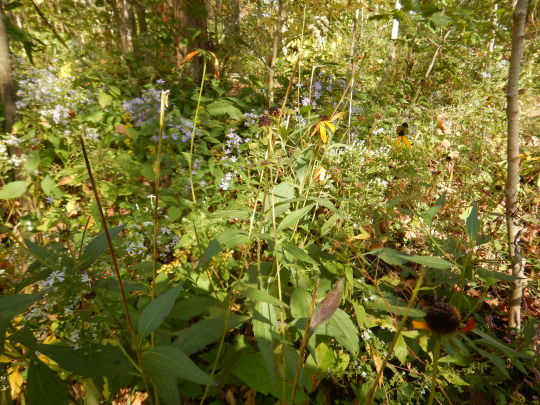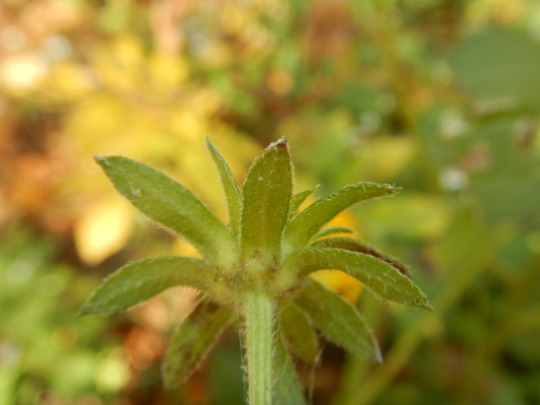#rudibeckia fuligida var.
Explore tagged Tumblr posts
Photo





Rudbeckia fulgida var.... growing with Symphyotrichum drummondii and other woodland asters.
While Rudbeckia fulgida complex is probably the worst for finding literature on isolating var. I wanted to give this one a try. Growing on calcareous mineral soil at the upper ridge of Clifton Gorge, not directly in water nor extremely cold permanent water. It was also growing in a section of woods that received dappled shade.
My first thought was it can’t be var. sullvantii due to fen obligation and true wetland obligate status. The second thought was the basal leaves were not dark enough or elongate enough to be var. umbrosia, the appalachian Rudbeckia fulgida, and also it’s difficult to consider that var. for range reasons. Var. umbrosia is also considered to be glabrous(smooth) and glossy. Var. Deamii is a prairie obligate in situ, at one point only occurring in one section of the prairie peninsula from Illinois barrens into Darby Plains and Sandusky Plains Ohio; now the only state that seems to have the tightly clumped surface to subsurface stolon to rhizome multi branched, hairy, clump colony forming var. is Indiana. Var. speciosa is an absolute unit, there for this can’t be it.
In fact i’ve heard a lot of jive about the ploidy of var. speciosa being something crazy enough to separate out of R. fulgida. Polyploid separation is nothing new in evolution and is constantly noted and var. speciosa has some huge leaves, capitulescence stypes, ligules , and leaves.
Other species from glade regions are frequently up for the idea of new species based on localized morphological var. or ecotypic non-plasticity.
https://www.friendsofeloisebutler.org/pdfdocs/rudbeckia_fulgida_abstract.pdf
^this abstract is one such paper that discusses potential separations.
I wanted to show y’all this because this paper immediately mentions a few things to the reader.
Paleae (poeaceae, asteraceae, proteaceae, goodeniaceae) goupings of florets and specifically those bracts that separates each floret from the base of the receptacle.

Unfortunately my camera wasn’t working right in macro mode that day but I tried to take a naked photo of these with the closest one to a successful shot being the blurry one with my hand. The outer floret bracts that greet the ligules are slightly ciliate, the inner bracts non ciliate. These plants did not occur in tight clusters from rhizome(below ground stem used for asexual colony formation or nutrient seeking cloning) or stolon(above ground stem used for asexual colony formation or nutrient seeking cloning). Instead, spread out colonies with single sections of inflorescence sparsely branching from top of the capitulescence(the stype that holds the capitulum and cauline leaves in asteraceae) with one- 3 capitulum rarely (aster family flower cluster) per individual per. plant. The involucre(the bractoid lads at the base of the receptacle) were sparsely pubescent(hairy) and cauline leaves scabrid (rough) and pubescent(almost stiff/hispid) while basal leaves were pubescent/ ciliate at the margins.
According to a few records true var. fulgida is range restricted, clump forming, and stoloniferous/ rhyzome clump forming. Paleae ciliate.
The plant does not seem to fit perfectly for R. fulgida var. truncata nor any other taxa mentioned therefor I give up until there is more evidence from the area.
For now it might as well be it’s own Rudibeckia fulgida var.
BTW seriously use that complex paper, its really good for help on var. that may one day be considered species(soon... probably. )
also stype can be used interchangeably with capitulaphore, literally means stalk in botanical jarble jargin for asteraceae.
#botany#ecology#ohio#rudibeckia#rudibeckia fuligida var.#rudibeckia fuligida#rudbeckia#rudbeckia fulgida#rudbeckia fulgida var.#wildflowers#species complex#evolution
43 notes
·
View notes
Photo




Pearl’s fen, Greene co. Ohio
Rudbeckia fulgida complex, a complex as complex as the Spiranthes cernua complex was to fix. In a complex, the data shown to support evidence for splits and for preserving taxon is usually broken up between concepts of morphological differences, habitat, ploidy, hybridization events shown in genetics, and pollinator specificity. Overlap in habitat as well as bloomtime is taken into account and the promotion of outcrossing with other similar members of the complex can be viewed by field botanists while reporting data. Other tests must be done in labs.
This specific example is that of Rudbeckia fulgida var. sullivantii, boreal fen black eyed susan. It’s range is something more prominent in calceric zones of the boreal mesic plains and sedge meadows near the tundras to the north; but is not limited to such areas due to it’s presence in marl beds and fens with hydrostatic and thermostatic ecosystems with alkaline chemistry.
Morphologically speaking this member is not significantly different then it’s counter parts, one thing that’s prominent is it’s ability to form pneumatophore like centers in new rhizomes when forming colonies and it’s glandular hairs. This species needs frequent moisture to be successful and will rarely be found outside of it’s noted habitats.
If you see a Rudbeckia fuligida growing in a fen, go and look for heavy glands, it could be Rudbeckia fulgida var. sullivantii.
#wildflowers#botany#ohio#fens#rudibeckia#rudibeckia fuligida var. sullivantii#plantblr#ecology#meadowcore#meadows#cottagecore#rudibeckia fulgida var. sulbantii#rudbeckia#rudbeckia fulgida var. sullivantii#rudbeckia fulgida
18 notes
·
View notes